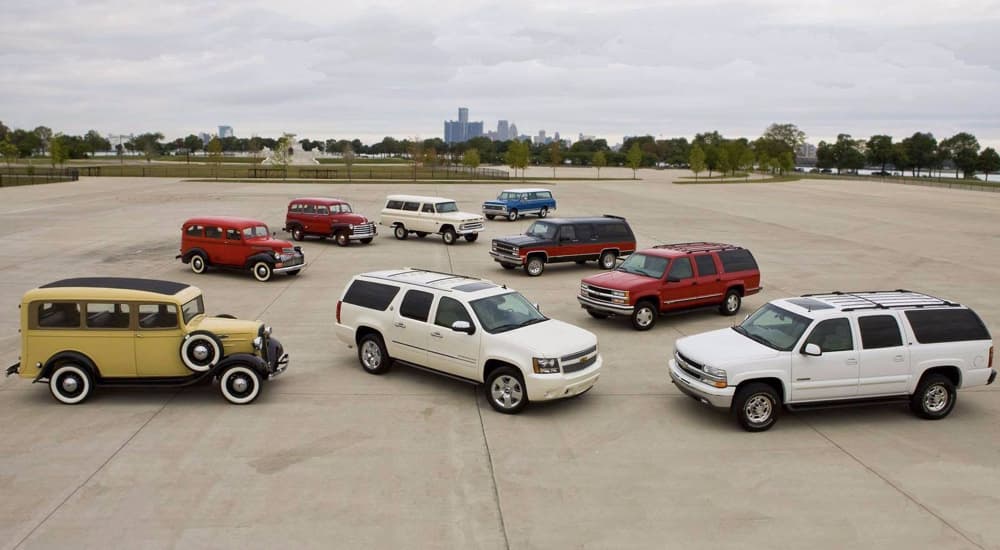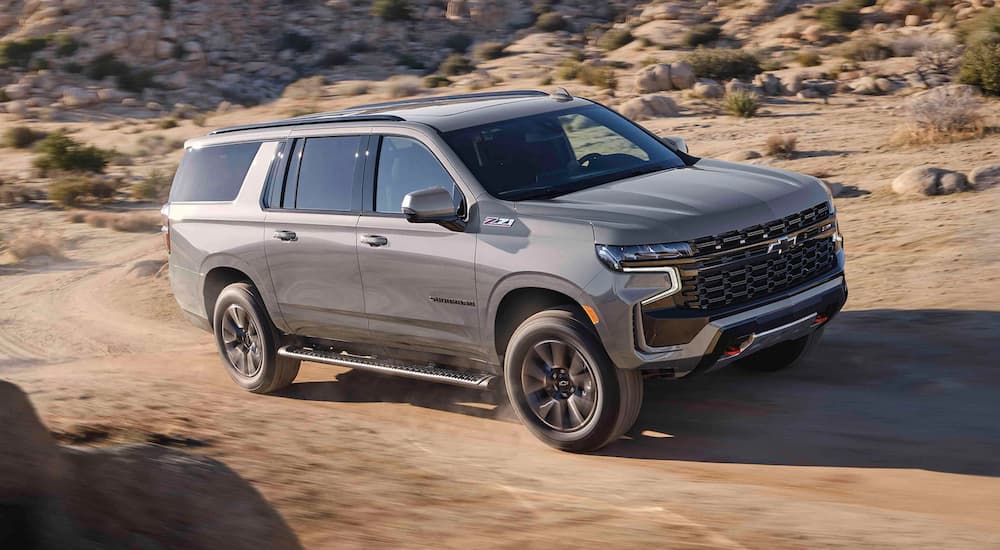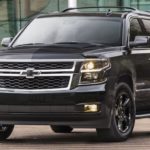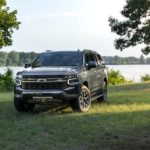Plenty of automakers have models that have been around for decades, from the Mustang to the Land Cruiser. But while some of these nameplates can trace their history back to the 1940s, the Chevrolet Suburban beats them all for the title of the longest-running nameplate in automotive history, having been in use since 1935. The Suburbans you see among new or even used Chevrolets today are pretty different from the ones that first rolled off the assembly line back in the first half of the 20th century. So let’s take a look at the storied past of the Chevy Suburban and see how the vehicle behind the name has evolved over the years.
1935: Birth of a Nameplate
The original Chevy Suburban was basically a cross between a truck and a station wagon called the Suburban Carryall. It differentiated itself from other wagons by having a steel body rather than wood sides and a canvas roof. For a while, the GMC equivalent of the vehicle was also called the Suburban, though it was eventually rebranded as the Yukon XL. In the early years, General Motors didn’t have exclusive rights to the nameplate, so other motor companies used the term “Suburban” to refer to a vehicle with a station wagon-type body on a truck-type frame, including Plymouth, Dodge, and Studebaker. But once Plymouth discontinued its Suburban, GM was able to trademark the name.
One thing none of these Suburbans were called at this time was “SUV.” For one thing, the term sport-utility vehicle didn’t come along until later, and it wasn’t really until the 1980s that the modern SUV was fully realized. However, even the earliest Chevy Suburban did have some of the features that SUV buyers are still looking for today, like plenty of space (enough to hold up to eight passengers) and rugged construction.
1941: Military Service
When America entered World War II, many resources were rationed for civilians so that they could be secured for use on the front lines. Vehicles use a lot of precious materials, so their production for the general public was cut back sharply during the war. However, the Suburban was produced during this time as a military transport vehicle, proudly serving its country overseas.
1947: A Commercial Workhorse
With the war over, the third generation of Suburbans was geared at American workers. The Suburban got a major redesign that was based on the Chevrolet Advance Design series of pickup trucks. One big upgrade was that the inline-six engine now produced up to 174 lb-ft of torque, giving it an excellent towing capacity.
1955: Exterior Redesign & Engine Upgrade
Generation four brought significant styling changes to the Suburban’s exterior. The running boards were scrapped for the 1955 model year, bringing the body flush with the fenders, and a new wraparound windshield increased visibility up front. There was a big change under the hood, too, as Chevy introduced its very first V8 engine. 1955 was also the first year that Chevy offered factory-installed four-wheel drive on the Suburban.
1965: Cool as a Breeze
One consistent throughline in the Suburban’s history is a shift toward a broader appeal. In the beginning, it was almost always used as a commercial vehicle, but today it’s firmly categorized as a personal vehicle. A big milestone in this direction is the addition of factory-installed air-conditioning and a rear-area heater, which could keep passengers throughout the vehicle comfortable in any season.
1973: Improved Interior
For its seventh generation, the Suburban got a complete redesign and was offered as a conventional four-door body for the first time. The wheelbase was also lengthened in order to give the driver and passengers more room to stretch out and get comfortable. This was another way that Chevy made the vehicle more appealing to personal-use customers.
2000: Rolling Into the New Millenium
The 2000 model kicked off the Suburban’s ninth generation, which brought new, modern styling on the outside as well as a redesigned interior. The changes for the new millennium weren’t just surface-level. The SUV also got four-wheel disc brakes for the first time, as well as a load-leveling suspension system for a smoother ride and electronic stability control for improved safety.
2007: Sleek & Safe
The redesign for generation ten smoothed out some of the body’s harsh angles and removed the chrome front and rear bumpers. This gave the exterior a sleeker and more aerodynamic appearance. As technology improved, Chevy was also able to offer more safety and driver assistance features, like hill start assist, blind zone alerts, and electronic trailer sway control.
2019: A Star Is Memorialized
Take a stroll down the Hollywood Walk of Fame, and you’ll find plenty of names of beloved actors, writers, and directors, but you won’t find too many plaques dedicated to cars. One name you will be able to find is “Chevrolet Suburban,” as the SUV was awarded a star on the iconic sidewalk in 2019. The Suburban broke the mold, becoming the first inanimate object ever to receive this honor, but according to Chevrolet, the model has made at least one TV appearance every year since 1956 and been in at least one film a year since 1960, so it certainly has an acting career worth celebrating.
2021: Bigger & With Better Tech
For the latest generation, Chevy introduced independent rear suspension to the Suburban, which added room to the cargo area and third row, making for a more spacious interior. To add even more space, the body was made longer, providing extra leg room all around. Of course, this model offers plenty of useful technology, including the option to add a rear-seat entertainment system featuring two 12.6-inch screens that can keep backseat passengers informed and entertained on even the longest of road trips.
2022: More Safety Becomes Standard
Coming hot off the heels of a fresh generation, the 2022 model year didn’t add much in the way of brand-new features. However, several optional features were expanded to more trim levels or even made standard across the board. The 6.2L V8 engine became available for RST, Z71, and Premier trims, and a customizable 12.3-inch digital gauge cluster was made standard for all trims except for the base LS. Every trim level for the 2022 Suburban comes standard with driver assistance features like front and rear parking sensors, lane-keep assist, lane-departure warning, and automatic high beams.
2023: Introducing Super Cruise
For the 2023 model year, a new cutting-edge tech feature became available on the Premier and High Country trim levels of the Suburban: Chevy’s Super Cruise. This feature offers hands-free driving on over 200,000 miles of compatible roads throughout North America. To achieve this, Chevy uses a combination of GPS, LiDAR map data, various cameras, and other sensors that keep track of the vehicle’s position, where you are in the lane, and what’s going on with vehicles and other objects around you. Now, this isn’t a fully self-driving car, and you do need to pay attention while behind the wheel and be ready to step in if necessary, but it is a big breakthrough in driver assistance technology that can make long road trips a lot more pleasant.
From Then to Now
Clearly, the Suburban has come a long way since its humble beginnings. Improvements in auto construction, innovations in technology, and the emergence of a whole new category of vehicles have worked together to turn a station wagon body on a truck’s frame into a modern large-and-in-charge SUV. In the decades ahead, the Suburban is sure to change even more to keep up with ever-evolving tastes and technologies. Perhaps by the time the Suburban reaches its 100th birthday, it will run entirely on electricity or be a full-fledged autonomous vehicle. We’ll just have to wait and see.






